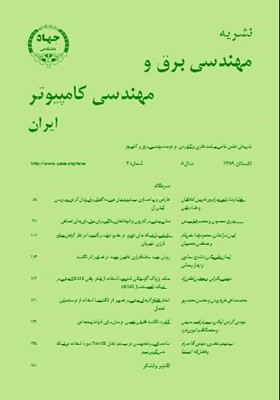حذف پژواک آکوستيکي استريو با استفاده از فيلتر وفقي NLMS مبتني بر شبکه ناهمبستهساز MIMO
محورهای موضوعی : مهندسی برق و کامپیوترمهدی بکرانی 1 * , مجتبی لطفيزاد 2
1 - دانشگاه تربیت مدرس
2 - دانشگاه تربیت مدرس
کلید واژه: آستانه عدم انطباق فيلتر وفقي سرعت همگرايي ناهمبستهسازي,
چکیده مقاله :
در يک حذفکننده پژواک آکوستيکي استريو وجود همبستگي متقابل شديد بين سيگنالهاي ورودي به دو کانال سيستم ارتباطي استريو سبب کندي قابل توجه سرعت همگرايي و همچنين عدم انطباق وزنهاي فيلترهاي وفقي با ضرايب پاسخ ضربه مسيرهاي آکوستيکي بخش گيرنده، حتي پس از اتمام دوره همگرايي ميگردد. در مقاله حاضر روشي براي بهبود عملکرد فيلتر وفقي NLMS بر مبناي کاهش همبستگي سيگنالهاي ورودي به کمک شبکه ناهمبستهساز چندورودي - چندخروجي ارائه شده است. ناهمبسته سازی در این روش به صورت غیرخطی بوده و در دو مرحله انجام میگیرد. نتايج شبيهسازيها نشاندهنده بهبود سرعت همگرايي فيلترها و کاهش قابل توجه حساسیت آنها به تغییر گوینده، با بهکارگيري اين ساختار پيشنهادي ميباشد.
Existence of a high inter-channel correlation in a stereo communication system results in a considerable performance degradation in the associated stereo acoustic echo canceller and also weight misalignment of adaptive filters even after finalizing the convergence period. In this paper an approach for improving the performance of NLMS adaptive filter is developed based on reducing the correlation of input signals employing a multi-input-multi-output decorrelation network. This approach has a low-complexity neural network structure and can train in a real-time manner. Simulation results show an improvement in weight convergence rate and misalignment employing the proposed method.

